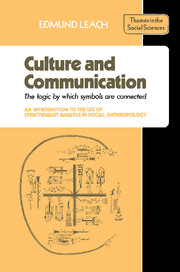 Culture and Communication
Culture and Communication Book contents
- Frontmatter
- Contents
- Culture and communication: the logic by which symbols are connected
- Introduction
- 1 Empiricists and rationalists: economic transactions and acts of communication
- 2 Problems of terminology
- 3 Objects, sense-images, concepts
- 4 Signals and indices
- 5 Transformations
- 6 Theories of magic and sorcery
- 7 The symbolic ordering of a man-made world: boundaries of social space and time
- 8 The material representation of abstract ideas: ritual condensation
- 9 Orchestral performance as a metaphor for ritual sequence
- 10 The physiological basis of sign/symbol sets
- 11 Mapping: time and space as reciprocal representations
- 12 Rank order and orientation
- 13 Examples of binary coding
- 14 Mating prescriptions and proscriptions
- 15 Logic and mytho-logic
- 16 Basic cosmology
- 17 Rites of transition (rites de passage)
- 18 The logic of sacrifice
- 19 Conclusion
- Bibliography
- Index
11 - Mapping: time and space as reciprocal representations
Published online by Cambridge University Press: 05 June 2012
- Frontmatter
- Contents
- Culture and communication: the logic by which symbols are connected
- Introduction
- 1 Empiricists and rationalists: economic transactions and acts of communication
- 2 Problems of terminology
- 3 Objects, sense-images, concepts
- 4 Signals and indices
- 5 Transformations
- 6 Theories of magic and sorcery
- 7 The symbolic ordering of a man-made world: boundaries of social space and time
- 8 The material representation of abstract ideas: ritual condensation
- 9 Orchestral performance as a metaphor for ritual sequence
- 10 The physiological basis of sign/symbol sets
- 11 Mapping: time and space as reciprocal representations
- 12 Rank order and orientation
- 13 Examples of binary coding
- 14 Mating prescriptions and proscriptions
- 15 Logic and mytho-logic
- 16 Basic cosmology
- 17 Rites of transition (rites de passage)
- 18 The logic of sacrifice
- 19 Conclusion
- Bibliography
- Index
Summary
One example of the general principle formulated at the end of Section 10 is an ordinary ordnance survey map.
In the terminology of Section 2 the map as a whole is an icon. It serves as a metaphoric description of the terrain and employs various devices of ‘planned similarity’, e.g. a ‘bend in a road’ corresponds to a ‘bend in a line’ on the map.
However a map of this kind is also a metaphoric representation of time. I can use it to work out itineraries, not only so that I have a list of the places that I must pass through in order to get from locality A to locality B but also so that I can estimate the time interval that I shall experience in the process of doing so.
In these respects each map must be viewed as a unity, but the map as a whole can only be interpreted if we first make ourselves familiar with the mutual significance of several dozen conventional signs which are arranged on the paper in patterns.
All this is a complex process and, bearing in mind that the individual signs are not arranged in linear sequence like the individual letters on the typeface you are now reading, or the notes on a musical score, it may seem rather remarkable that we can read a map at all. Yet the making and reading of two dimensional maps is almost universal among mankind whereas the reading and writing of linear scripts is a special accomplishment associated with a high level of social and technical sophistication.
The explanation of this seeming paradox lies in what has already been said in Section 7.
- Type
- Chapter
- Information
- Culture and CommunicationThe Logic by which Symbols Are Connected. An Introduction to the Use of Structuralist Analysis in Social Anthropology, pp. 51 - 52Publisher: Cambridge University PressPrint publication year: 1976


